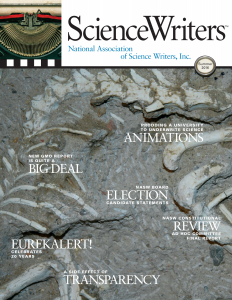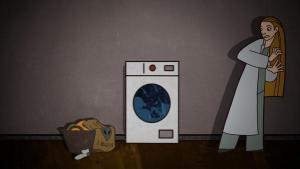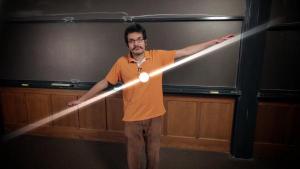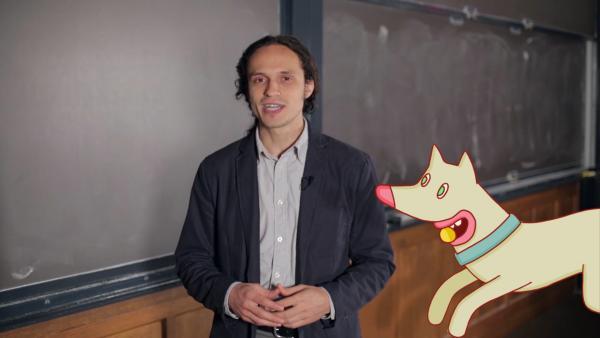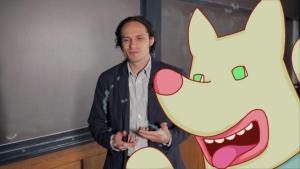The following is the strange and improbable tale of the founding of Ultra-Condensed Science, an animated science series at Washington University in St. Louis.
By Diana Lutz
I learned science one-on-one with scientists who drew lots of diagrams, watched to see if I understood, backfilled when I didn't, told jokes, and talked shop. That interaction had a lot to do with why I loved science and scientists.
When YouTube Science Channels came along, I subscribed. Henry Reich's Minute Physics was one of the first I saw, and I was thrilled to hear Reich say he wanted people watching his animations to feel like he was sitting next to them showing them something on a piece of paper.Inspired, I began a campaign to get my university to underwrite science animations starring our graduate students and faculty. I wrote up talking points; found other universities with science animations; emailed everybody links to great animations; talked to graduate students; talked to department chairs; and, in general, made a nuisance of myself.
Most of the scientists were enthusiastic. But enthusiasm is one thing and money is another. In order to make a credible case, I had to propose a budget. The only problem being that I had no idea how much animation cost.
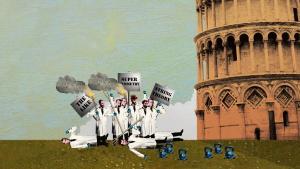
Hold on to your hats, folks. We're talking $8,000 for a three-minute animation and $12,000 or more if you crave the stylishness of a top-flight London studio that doesn't need your business.
That said, it is possible to do entertaining animation cheaply, if you know someone who can draw well.
Meanwhile, lobbying for three years for an animation channel was going nowhere and I was giving up hope. Then the top spot in my office turned over for the first time in 20 years, and the new broom swept clean. We went completely digital, someone was hired to "do social," video overtook photography, and everyone was required to Slack and tweet.In the general upheaval, there was a lot of turnover and I got a new boss: a woman willing to ask for money with all the risk that implies. She asked and we received.
Fortunately, I was ready. National Geographic had brought FameLab to our campus, and I had been to every event, so I knew some graduate students who were "animated" speakers. Also, we hired a videographer who "got it" when it came to science and creative collaboration.
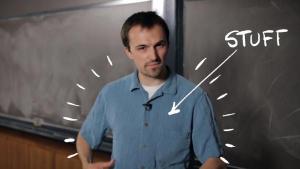
Pruitt scripted his talk on his own and delivered it in one flawless take. Jorge Cham of PhD Comics animated the video without coaching or correction. The videographer added sound effects and an in-house graphic designer made an animated title page for the series.
When the physics chair showed the first animation to a class discussing science communication the students spontaneously broke into applause.
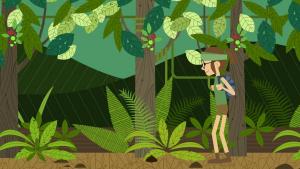
Actually, beginner's luck.
One thing I didn't quite get was that when I say "animation," I think ViHart or Henry Reich. Others think Saturday morning cartoons. This led to a persistent tendency for the animations to trend "young." As a result, I've had to squelch booger jokes and poop jokes, and "kill" some Supermen and a nifty horseshoe-magnet-shaped spacecraft. In doubtful cases, I ask myself whether the scientist could show the animation to a potential employer and be taken seriously.
There were other glitches as well. I hired one animator because his renderings of water flowed like water, only to have him put alchemical symbols for the planets in an astronomy video. Those were removed at the animatic (animated storyboard) stage, but I never did get rid of the alien in the laundry basket.
We also had our share of rough goes with scientists. Re-scripting and re-taping helped some. But there isn't much that can be done when a scientist can't relax enough in front of a camera to speak with a natural cadence.We've done some beautiful work that has been well received, but I'm still not totally satisfied. At times, I feel the animation overpowers the science. It is so expensive I worry constantly that the budget will be cut. More importantly, I worry that we've drifted away from the original idea that the animations would convey the warmth and enthusiasm with which scientists talk about their science. So I am constantly trying to push for a more spontaneous and informal look.
It's all a big experiment and none of us knows how it is going to turn out in the end, but I am hopeful and deeply grateful for the opportunity to try and show more people the passion, beauty, and joy of science.
To watch the animations, visit ultracondensedscience.wustl.edu. If you want to get new animations as they are posted, please subscribe.
Diana Lutz is senior news director of science, Washington University in St. Louis.
The tale of two Pinkertons
The star of this animation is a scat-sniffing Belgian malinois named Pinkerton. Because the first animator was a medical illustrator the result was too realistic, looked more like a German shepherd, and worst of all was static instead of gamboling. I made iPhone movies of my own dog to show her the mannerisms and actions I wanted. When that and other attempts failed the animator got a kill fee.
A second animator went in a completely different direction. Her dog doesn't look like a flesh-and-blood animal, but like a cartoon. Better yet, it behaves like a dog wagging its tail and licking the viewer (via the screen). How the animation moved was ultimately more important than how it looked. This dog with the Mr. Bill lips is the one that appears on our site.
NASW members can read the rest of the Summer 2015-16 ScienceWriters by logging into the members area. Free sample issue. How to join NASW.
